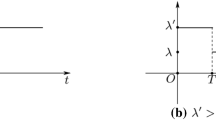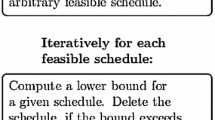Abstract
In this paper we consider a 1-warehouse, N-retailer inventory system where demand occurs at all locations. We introduce an inventory model which allows us to set different service levels for retailers and direct customer demand at the warehouse. For each retailer a critical level is defined, such that a retailer replenishment order is delivered from warehouse stock if and only if the stock level exceeds this critical level. It is assumed that retailer replenishment orders, which are not satisfied from warehouse stock, are delivered directly from the outside supplier, instead of being backlogged. We present an analytical upper bound on the total cost of the system, and develop a heuristic method to optimize the policy parameters. Numerical experiments indicate that our technique provides a very close approximation of the exact cost. Also, we show that differentiating among the retailers and direct customer demand can yield significant cost reductions.
Similar content being viewed by others
References
S. Axsäter. (1990). “Simple Solution Procedures for a Class of Two-Echelon Inventory Problems.” Operations Research 38, 64–69.
S. Axsäter. (1993). “Continuous Review Policies for Multi-Level Inventory Systems with Stochastic Demand.” In S.C. Graves, A.H.G. Rinnooy Kan, and P. Zipkin (eds.), Handbooks in Operations Research and Management Science, Vol. 4. Elsevier Science/North-Holland.
R. Dekker, R.M. Hill, and M.J. Kleijn. (1997). “On the (S - 1, S) Lost Sales Inventory Model with Priority Demand Classes.” Technical Report 9743/A, Econometric Institute, Erasmus University Rotterdam, The Netherlands.
E.B. Diks, A.G. de Kok, and A.G. Lagodimos. (1996). “Multi-Echelon Systems: A Service Measure Perspective.” European Journal of Operational Research 95, 241–263.
A.Y. Ha. (1997). “Inventory Rationing in aMake-to-Stock Production System with Several Demand Classes and Lost Sales.” Management Science 43, 1093–1103.
J.A. Muckstadt and L.J. Thomas. (1980). “Are Multi-Echelon Inventory Methods Worth Implementing in Systems with Low-Demand Rate Items?” Management Science 26, 483–494.
S. Nahmias, and W. S. Demmy. (1981). “Operating Characteristics of an Inventory Model with Rationing.” Management Science 27, 1236–1245.
C.C. Sherbrooke. (1968). “METRIC: A Multi-Echelon Technique for Recoverable Item Control.” Operations Research 16, 122–141.
D.M. Topkis. (1968). “Optimal Ordering and Rationing Policies in a Nonstationary Dynamic Inventory Model with n Demand Classes.” Management Science 15, 160–176.
F. de Véricourt, F. Karaesmen, and Y. Dallery. (2001). “Assessing the Benefits of Different Stock-Allocation Policies for a Make-to-Stock Production System.” Manufacturing & Service Operations Management 3, 105–121.
Author information
Authors and Affiliations
Rights and permissions
About this article
Cite this article
Axsäter, S., Kleijn, M. & de Kok, T.G. Stock Rationing in a Continuous Review Two-Echelon Inventory Model. Annals of Operations Research 126, 177–194 (2004). https://doi.org/10.1023/B:ANOR.0000012280.68155.a3
Issue Date:
DOI: https://doi.org/10.1023/B:ANOR.0000012280.68155.a3




